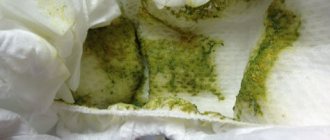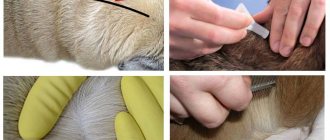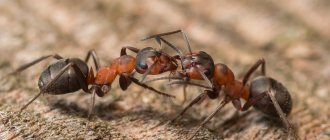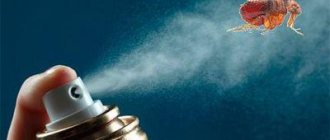Related Posts
- Fleas in rabbits: symptoms and treatment
Fleas in the apartment: where, why and how to deal with it?
How to get rid of fleas on guinea pigs
Flea bites on humans do not pass without a trace: bloodsuckers bite very painfully, unlike the same bugs and ticks. This phenomenon is explained simply: when bedbugs bite a victim, they inject saliva with an anesthetic enzyme into the wound. Therefore, a person feels discomfort from a bite only after a time when the parasite has already managed to hide. Read about bedbug bites in the article “How dangerous are bedbugs and what are the consequences of their bites?”
Nature has not endowed jumping bloodsuckers with the ability to anesthetize a bite. But she endowed them with the smallest size and strong chitinous covers, practically not vulnerable to mechanical stress. Thanks to these features, the flea is quite difficult to catch or crush.
There is an opinion that cats, dogs and other warm-blooded animals suffer from jumper bites, but the flea does not live on humans. But this is not so: the nightly attacks of bloodsuckers make every person in the infected house suffer. Parasite bites have certain signs that allow you to understand whether fleas bite people.
Why is the danger of flea bites greater for children than for adults?
- A child’s skin is thinner and more vulnerable – so a flea bite is especially painful, it can be scratched and does not go away for a long time.
- Children are prone to allergies because... their immune system is weaker than that of an adult.
- The flea is a carrier of infections and eggs of most helminths (we talk in more detail about the danger of fleas to humans here).
Prevention
Knowing how dangerous a flea bite is to humans, it is important to prevent its appearance and spread in the apartment. Preventive measures can help with this. You should regularly inspect your pet's coat for fleas. Take your dog or cat for a walk wearing a special anti-flea collar. Periodically use special flea products. They are especially necessary when your pet comes into contact with stray animals.
Realizing the danger flea bites pose to humans, you can get rid of parasites correctly and in a timely manner.
How to recognize flea bites in children?
Flea bites can easily be confused with the bites of other blood-sucking insects, but there are still some peculiarities. Let's carefully examine the bite site.
- flea bites are very painful and cause severe itching (learn how to deal with such itching here);
- “bumps” form in the affected areas with slight subcutaneous hemorrhage , and the lumps and red spots do not go away for quite a long time;
- bites are not single - tracks of several wounds are immediately visible;
- Most often, areas not protected by clothing are affected : for example, the lower back, ankles. As a rule, a flea is not able to penetrate or bite through clothing.
As already mentioned, the tendency of children to have an allergic reaction is very high. And often even a single flea bite leads to the appearance of rashes on the skin. This is an alarming signal - it's time to take action.
Next you will see a photo of flea bites on a child:
Can animal fleas be transmitted to humans?
Despite the fact that cats are the preferred hosts for blood-sucking parasites, small pests can attack and bite humans to satisfy their hunger. Insects briefly move onto people, pursuing only this goal. They prefer to breed and lay eggs in darker, humid and warmer places. In basements, garbage dumps, even in doghouses, fleas are dangerous to humans, as they can inflict a painful bite.
Important!
Regular inspection and treatment of animals with special means will help prevent flea bites in humans.
Where to begin?
- Do not panic! Wash the bite site with any available antiseptic : it can be hydrogen peroxide, chlorhexidine, or even just water and laundry soap.
- Take steps to relieve the itching . You can apply a cotton pad with soda solution or an ice cube wrapped in a clean cloth to the affected area. A good folk remedy is to wipe the wound with apple cider vinegar diluted in water.
- If a severe rash appears, give your child an antihistamine .
Important ! The water should be cold - hot and warm water only intensifies the itching.
Helminth infection
Parasites become the main cause of helminth infection. There are two types of such problems that are worth understanding in more detail.
Dipylidiasis
The tapeworm is the causative agent of this type of helminthiasis. Arctic foxes, cats, dogs and other animals face similar diseases. Tapeworm larvae are found in fleas that live on pets. If the parasite accidentally gets into a person's mouth, he will become infected. In just 20 days, the worm can grow up to 70 centimeters in length. The disease is asymptomatic, but you should be alert to the following signs:
- pain in the abdomen, diarrhea;
- lack of sleep and appetite;
- allergic reactions;
- sudden changes in behavior.
Hymenolepiasis
Rat tapeworm is the causative agent of this disease. The flea larva swallows the helminth egg, so the worm begins to develop in it. If a flea gets into a person's mouth, he will instantly become infected. The disease occurs without pronounced symptoms, but if sharp pain occurs in the stomach area, you should urgently go to the doctor. If there are too many helminths in the body, weight may begin to disappear, and the anus may become very itchy. This tapeworm grows up to 60 centimeters in length in a minimum amount of time.
Why is this so important?
As a rule, the allergen is eliminated from the body on its own after two to three days. But! The rash may be the start of a more serious allergic reaction. The main symptoms are:
- enlarged lymph nodes;
- temperature rise to 38-39°;
- swelling, nasal congestion;
- diarrhea.
Severe itching makes the baby restless and he begins to scratch the bites, increasing the risk of infection.
If flea bites cause severe allergies, you should not take it lightly, leave the situation uncontrolled, or self-medicate. Only an immunologist will prescribe competent treatment and select medications individually for your baby.
Eliminating the causes of the disease is the best prevention.
We told you how to recognize flea bites in children and how to eliminate unpleasant consequences. But, of course, the best prevention is the absence of insects in your home!
The danger of fleas to humans
How dangerous are fleas to humans? First of all, there is a risk of contracting some kind of infectious disease from these parasites. However, this probability is very low.
Many infections carried by fleas are fairly safe for humans who have received a standard set of vaccinations.
And the likelihood that a flea that has bitten a person will carry a dangerous disease is low. But these parasites are dangerous not only by transmitting infections. Any flea attack on a person threatens the development of unpleasant consequences caused directly by the fact of the bite.
What consequences can a flea bite cause?
The most common consequences of the bites of these ectoparasite insects are the body's reaction. Firstly, it is painful.
Many ectoparasites, when piercing or biting the skin of their host, secrete anesthetic substances along with saliva.
This is a kind of camouflage method, thanks to which the animal or person at first does not pay attention to the fact of the bite. However, in fleas at different ages, the saliva is saturated with analgesic components differently. It happens that during a bite, especially in those places where the skin is tender and unusual to external influences, a person feels significant pain.
There will be swelling and itching at the site of the bite
Secondly, the danger lies in the possibility of developing serious skin irritations. A pimple, redness, and irritation causing itching remain at the site of the bite. Unpleasant sensations appear. A person may scratch the area, thereby increasing the area of inflamed skin. There is even a possibility that an infection will be introduced into the damaged skin in this way. Various types of dermatitis can develop. This likelihood is especially high in people with delicate skin and children. To avoid such consequences, it is advisable to immediately lubricate the bite sites with creams, ointments, and compounds that relieve itching and scabies. Anti-inflammatory ointments also help. To learn how allergies can manifest themselves, watch this video:
Thirdly, flea bites in some cases can cause acute allergic reactions, leading to skin irritation, swelling, swollen lymph nodes, a significant increase in temperature and a general deterioration in well-being. In such cases, it is necessary to consult a doctor so that he can prescribe the necessary antihistamines. At the same time, an allergic reaction may be a consequence of a psychosomatic reaction. For many people, parasitic insects cause real panic attacks. It is very important here to calm down and understand that truly dangerous diseases are transmitted from fleas to humans very rarely.
OUR READERS RECOMMEND! In the fight against bedbugs, our readers recommend the Pest-Reject repeller. Electromagnetic and ultrasonic technology is 100% effective against bedbugs and other insects. Absolutely safe, environmentally friendly product for humans and pets. Read more here...
Flea-borne infections
Despite the fact that there is an extremely low probability of contracting a dangerous disease from a flea, you should still be aware of the threat these parasites can pose. The most dangerous viral diseases that can be transmitted from animals (for example, rats) to humans through fleas are:
- anthrax;
- encephalitis;
- trypanosomiasis;
- plague;
- tularemia;
- typhus;
- listeriosis;
- salmonellosis.
The names are really scary. Therefore, if, after insect bites have been discovered on a person’s body, he feels a significant deterioration in health, nausea, fever and other symptoms of infectious diseases, it is important to immediately consult an infectious disease doctor. Timely diagnosis and initiation of therapy make it possible to quickly treat a variety of infections carried by parasites, while minimizing the risk of serious consequences and complications.
Fleas can become carriers of serious diseases
Much more often, people become infected from fleas with the non-infectious diseases listed above, but with endoparasites, that is, organisms that then live and reproduce in the human body.
Thus, fleas carry a huge number of different types of helminths.
At the same time, worms of one type or another can be picked up not only as a result of a bite. Situations are quite common when a person crushes a caught insect with his nails. At this moment, helminth eggs remain on the finger. Then, without washing his hands, a person can eat something or simply scratch his finger near his mouth, nose or wound. This may be quite enough for endoparasites to settle in the human body for a long time. In turn, various helminths that settle in organs can cause significant harm to health. For more information about flea-borne diseases, watch this useful and relevant video:
It is important to emphasize that fleas can cause especially great harm to children’s bodies. Children's skin is more delicate and prone to irritation. In addition, the child will not control himself as much as an adult, which means he will scratch the wounds at the bite sites more strongly. Children are also more susceptible to allergic reactions. Finally, the child may not yet have received basic vaccinations that protect the body from infections carried by parasitic insects. Therefore, before getting a cat or dog, you should think about whether this will bring more harm to the child’s health than the benefits of communicating with pets.
How do fleas appear in a home in the first place?
- they are brought “on their own skin” by pets;
- harmful insects can move into your home from the street, basement and other apartments.
For reference ! Favorite habitats for insects are carpets and upholstered furniture. They also live under baseboards, in hard-to-reach places.
Their food is dirt and garbage, so remember - order and cleanliness are the key to a healthy climate in your home .
We talked about how fleas get into houses in a separate article, but here you can find out where they come from in houses and apartments.
Once there are fleas in the house, it will not be so easy to get them out.
Types of fleas that live on pets
In nature, there are fleas that live not only on animals, but also on people, rodents and even birds. Each insect adapts to the characteristics of its victim (skin, body temperature, blood, etc.). However, in the absence of such a “food source,” the blood-sucking parasite is able to be content with any nearby warm-blooded organism.
Many owners of mustachioed pets wonder whether cat fleas are dangerous for humans. Parasites can live in dirty basements and various landfills where sick and even dead animals are located. If you have a cat at home that regularly goes outside, you should not exclude the possibility that it is quite capable of bringing such insects into the house.
Fleas
Therefore, fleas on cats are dangerous to humans. Feeding on the blood of an infected animal, they absorb infectious agents, which they subsequently transmit through a bite to a new host. It could be:
- salmonellosis;
- plague;
- encephalitis;
- typhus;
- listeriosis or tularemia.
Moreover, cat fleas attack people 3 times more often than dog parasites.
Fleas living on dogs can choose warm-blooded animals such as cats or horses as their victims. They do not live on humans, but in severe hunger they will not disdain his blood.
Treatment at home, folk remedies
There are several traditional treatments that are available to most people. Although they may not be as effective as some of the creams and medications we have already mentioned above, they are significantly safer.
Learn more How to get rid of thrips on indoor plants
Tea bags
Drink tea and use a bag for flea bites! After you have finished drinking tea, place a tea bag on the affected areas of the skin, this can help neutralize itching and promote healing.
Black tea has medicinal properties and can be used effectively for this problem.
Baking soda
The use of baking soda is a safe, cost-effective remedy. Simply mix a small amount of water with baking soda to form a paste and apply it to the bitten areas.
Within a few minutes you will feel the itching subsiding.
Aloe vera
Aloe is great for treating burns and other skin diseases, but it is an excellent remedy for relieving itching and healing skin from flea bites.
You can buy it at the store and keep it always on hand. Aloe Vera is sold in gel form or when you have an aloe plant growing at home, simply tear off a leaf, peel it and apply it to the wounds, rub in generously and within a few minutes the itching should stop.
Lemon juice
Applying lemon juice may seem painful, but afterward, the itching actually goes away. The astringent power of lemon juice cleanses the wound area, so it is a dual treatment method.
Lavender oil and basil
Lavender oil and basil are used in combination for inflammation.
These two are natural, great-smelling remedies, lavender is great for soothing the skin and basil is anti-inflammatory. If you can refrain from scratching the wound, you are safe from infection.
Here are a number of other products that help alleviate the condition:
- Vinegar;
- Ice or cold water soothes the skin and prevents swelling and inflammation.
You should also clean the infected area with water and antiseptic soap, which prevents the growth of all kinds of nasty bacteria.
Flea bites on people do not leave scars and disappear after a few weeks. If you want to get rid of a flea bite faster, you can follow the tips below.
IMPORTANT! This procedure should only be used when the wound no longer itches.
Use a soft exfoliant for the face (mechanical or chemical means for removing dead skin cells, peeling). Apply some moisturizer to the bite area.
Repeat this procedure. Be very careful as this may cause irritation. Use sunscreen every time you go outside. New skin is very sensitive to light. It will become darker than the rest of the body when exposed to sunlight.
How to prevent fleas from coming back
Blood-sucking creatures do not initially live on the human body. There are certain paths by which they get into the apartment. Biting insects penetrate in the following situations:
- On the fur of cats and dogs that are outdoors.
- Along with pieces of dirt on shoes after a walk.
- After repairs, parasites may appear.
- Neighbors who have pets with fleas can transfer it.
- From basements, this often happens in old houses.
- Insects can settle in dried out baseboards and cracks if repairs have not been done for a long time.
Crossed out flea sign
To avoid these insect bites in the future, it is necessary to carry out a number of preventive measures:
- It is necessary to carefully examine pets and, if parasites are found, treat the animals with special insecticides.
- Thorough cleaning is carried out throughout the premises. Pet bedding, carpets and bedspreads can also be treated. All surfaces must be vacuumed and disinfected. After two weeks, repeat the treatment, because this is how long it takes for a flea larva to transform into an adult.
- In order to prevent fleas from appearing again, it is necessary to use insect repellents. They are sold in a large assortment at the pharmacy. But you can easily prepare them at home. A citrus-based spray is very effective. The lemon, cut into slices, is poured with water, brought to a boil, and then allowed to brew for several hours. The room is sprayed with this decoction. Lavender and eucalyptus oils also have a repellent effect.
Following these preventive measures will help prevent fleas from appearing in your apartment and protect yourself from bites.
Actions when bitten
If you find a sea flea bite, remember not to scratch the skin, as this leads to infection. You should take some steps and use products that will improve the condition of the affected skin area and relieve symptoms.
These include:
Shower. The very first thing to do is take a shower
But it is very important to shower without a bathing suit. The fact is that there may be larvae on it, which already at this stage of development need nutrition and cause painful bites. After the attack of the larvae, a rash and irritation appear
It is also necessary to wash your swimsuit/swimming trunks and towels. Before washing, wipe them with alcohol or vinegar and then wash them with detergent.
After the attack of the larvae, a rash and irritation appear. It is also necessary to wash your swimsuit/swimming trunks and towels. Before washing, they are wiped with alcohol or vinegar, and then washed using detergent.
Vinegar, alcohol. These remedies help get rid of unbearable itching. To do this, you need to soak cotton wool in vinegar and apply it to the affected area, then let the product dry on the skin. You can also dilute alcohol with water and apply it to the bite, in this case it helps get rid of toxins.
Cold compress. You can use ice, which is wrapped in a cloth or towel and applied to the sore spot. Allows you to relieve swelling and get rid of severe pain.
Calamine lotion. This remedy perfectly relieves itching. This drug is not recommended for use in children under 6 months of age, as well as in pregnant women and during breastfeeding. Hydrocortisone ointment has a similar effect, but for children under 10 years of age it can only be used after consultation with a doctor.
Soda. This remedy will help get rid of itching and relieve inflammation. You can use soda as a compress; for this, take 3 tablespoons of soda and dilute with 1 spoon of water. A thick paste is applied to the affected area for half an hour. You can also take a bath with baking soda; for this you need to use 1 glass of powder per bath of water. You need to stay in such a bath for at least half an hour. Instead of baking soda, you can add 2 cups of oatmeal to the bath, which has a similar effect. Remember that the water should not be hot, as this can make the situation worse.
Aloe vera. Preparations with aloe vera have an excellent effect on the skin, relieve inflammation, and reduce irritation.
Essential oils. Cedarwood, lavender, and tea tree oils are used, which relieve irritation well.
Anti-inflammatory, non-steroidal drugs. They help relieve pain and inflammation, these include aspirin, ibuprofen and others.
If you detect a bite from a female, be sure to consult a doctor, since it is necessary to remove the parasite in order to prevent complications. In addition, when the symptoms do not go away, and the site of the lesion is disturbing, medical attention will also be required, since this indicates an infection or a possible allergy to the saliva of the parasite, which requires treatment.
Unfortunately, there are cases where, after a bite from this small parasite, sepsis developed, which led to amputation of the fingers. An attack by these fleas cannot be ignored as the consequences can be quite serious and life-threatening. Sometimes symptoms manifest themselves as headaches, nausea, weakness, fever, which in turn, without proper treatment, leads to serious consequences.
Fleas from exotic countries
Exotic fleas are an “exotic” danger to humans. They are widespread in India, Vietnam and the Caribbean. Parasites bite under the nails or stick to the blood vessels. In just a few days they double in size.
If you do not respond to the situation in a timely manner, you may face serious problems. These are generalized inflammations, gangrene, plague. If you are bitten by a parasite, be sure to consult a specialist so as not to worsen the situation.
A small percentage of the population in these areas becomes disabled. This occurs due to the bites of sand fleas, which are activated during the hot season, actively obtaining food for themselves.
Appearance and behavior of the flea
At first glance, the flea is harmless, but in the photograph it looks scary. The brown insect feels good in wool. It behaves actively - it jumps to a height of up to 20 cm. The peculiarity of the insect is that it has three pairs of legs, the hind ones of which are much longer than the front ones.
The small parasite has a developed jaw. Thanks to its sharp teeth, it quickly digs under the skin. A flea cannot be compared with a bedbug, since insects have many differences. The bug pierces the skin, clinging to its surface.
The flea digs in, spreads the edges of the wound and salivates. The insect's head touches the capillaries. Saliva does not contain anesthetic substances , so a person immediately feels pain.
The flea is a tenacious and practically invulnerable creature. When it feeds on blood, it releases an enzyme that interferes with clotting. The dose is negligible, but it is enough to cause itching. Flea bites are accompanied by swelling; tick bites do not lead to such reactions. If the parasite has enough food, it eats every day. During the period of hunger strike, the flea goes into hibernation, which can last up to 12 months. After the insect awakens, it attacks the victim again.











